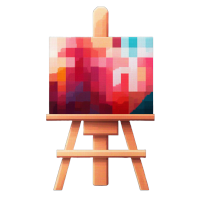Advanced Techniques for Mixing Vibrant Landscapes: Oil Painting Tips
Introduction
Welcome to this oil landscape painting tutorial aimed at intermediate to advanced artists. In this guide, we'll cover advanced oil painting techniques that help you create dynamic, eye-catching scenes. Color mixing is crucial for achieving a vibrant landscape oil painting because it brings depth, realism, and energy to your work. By mastering how to layer colors, vary tonal values, and push contrast, you can make your painted landscapes truly come alive.
Oil paint offers a rich spectrum of hues and blending capabilities, but without the right approach, colors can appear dull or flat. We will explore how careful mixing and layering of oil colors can produce luminous skies, vivid foliage, and striking contrasts between light and shadow. The importance of layering, tonal variations, and contrast in landscape painting cannot be overstated – these elements give your scene a sense of depth and atmosphere. Ready to elevate your landscape painting skills? Let's dive into these advanced techniques for mixing vibrant colors and creating stunning vistas on canvas.
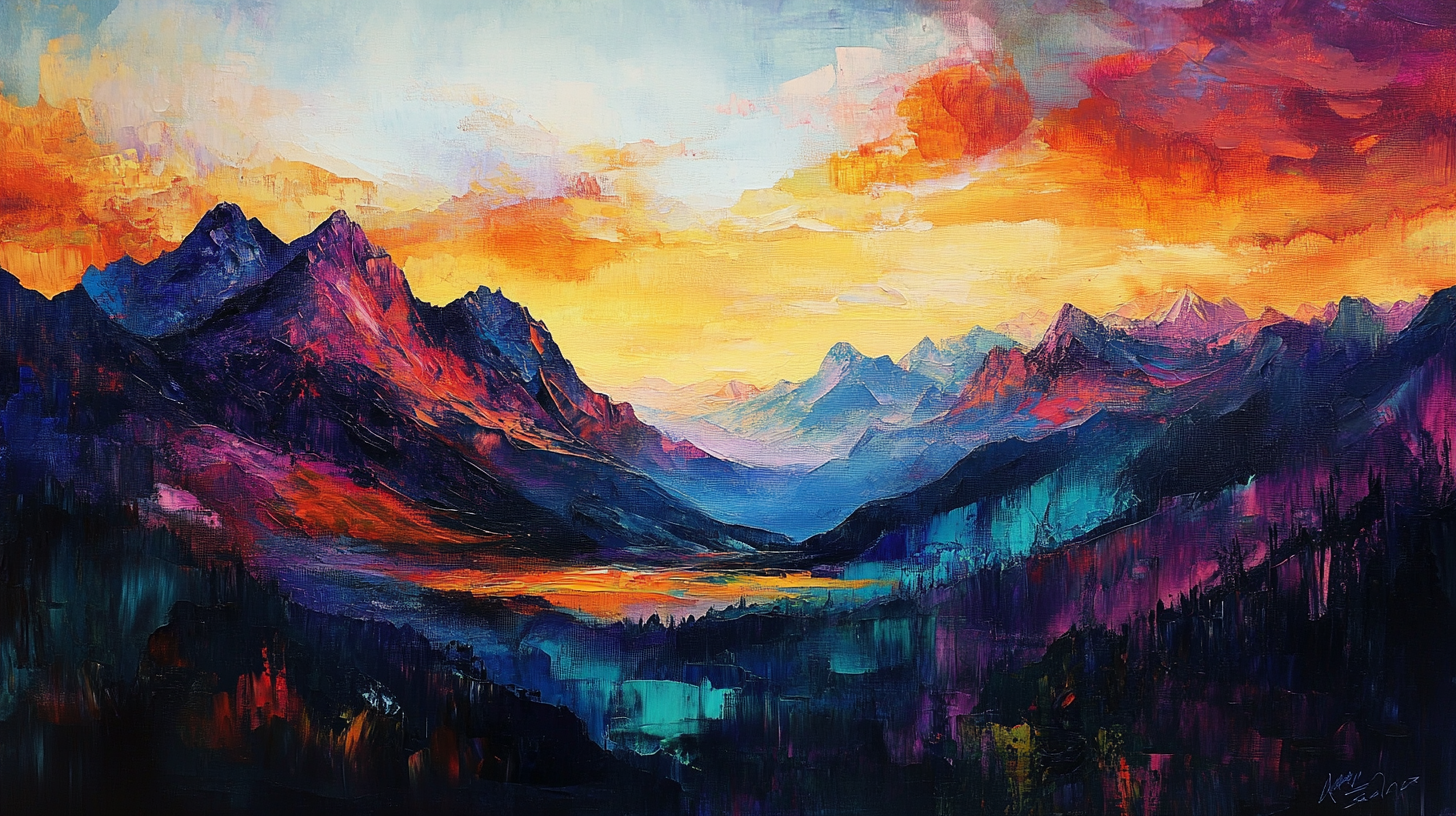
Materials and Setup
Before diving into advanced techniques, ensure you have quality materials:
- Oil Paints: Professional-grade oils with high pigment concentration
- Brushes: Various sizes of filbert, flat, and round brushes
- Palette: Glass or wooden palette with ample mixing space
- Medium: Linseed oil or painting medium for consistency control
- Canvas: Primed canvas or panel suitable for oils
- Additional Tools: Palette knives, cleaning supplies, paper towels
Proper setup is crucial for successful color mixing. Arrange your palette with primaries around the edge and leave ample space in the center for mixing. Good lighting is essential - natural north light is ideal, but a daylight-balanced lamp works well too.
Understanding the Color Palette for Landscapes
Selecting the right color palette is the first step toward vibrant landscape paintings. An effective palette for landscapes typically includes a balanced mix of warm and cool tones, which allows you to capture the variety of nature's colors. Many experienced painters use a limited set of high-quality oil paints – often a warm and cool version of each primary color – to mix virtually any hue needed. For example, having both a warm yellow (like cadmium yellow deep) and a cool yellow (like lemon yellow), a warm red (cadmium red) and a cool red (alizarin crimson), and a warm blue (ultramarine blue) and a cool blue (cerulean or phthalo blue) provides tremendous mixing flexibility. Adding a few earth tones (such as burnt sienna or raw umber) also helps in creating natural looking greens and browns. This kind of limited palette ensures color harmony and reduces the chance of unintentionally muddy mixtures.
Warm vs. Cool Tones: Understanding temperature in colors is key to landscape work. Warm tones (reds, oranges, and yellows) tend to appear lively and can be used to highlight sunlit areas like a bright sunset sky or sun-bathed fields. Cool tones (blues, greens, and purples) are excellent for indicating shaded areas or distant elements. In fact, using warm colors in the foreground and cool colors in the background helps create depth – warm hues seem to come forward while cool hues recede into the distance. For instance, a distant mountain might have a bluish-grey cast (cool) whereas closer rocks or trees could have warmer, richer greens and browns.
Primary, Secondary, and Complementary Colors: A strong grasp of basic color theory will vastly improve your oil paint mixing for landscapes. Primary colors (red, yellow, blue) are the foundation – they cannot be mixed from other colors, but you will mix them to create secondary colors (green, orange, purple). In landscape painting, you'll often mix a variety of greens (blue + yellow) for foliage or turquoise tones (blue + green) for water. Complementary colors are pairs opposite each other on the color wheel (such as blue and orange, red and green, yellow and purple). They play two important roles:
- Vibrant Contrast: Placing complementary colors near each other in your painting makes each appear more intense (for example, a reddish-orange sunset sky against a blue mountain silhouette creates a brilliant contrast).
- Neutralization: Mixing complementary colors together will neutralize them (yielding grays or browns). This is useful when you need to tone down a color's intensity. For instance, if your green foliage is too vivid, adding a tiny touch of red (green's complement) can create a more natural olive tone. Just be cautious – overmixing complements can quickly lead to muddy colors, so add little bits at a time.
By carefully choosing your palette and understanding these color relationships, you set the stage for successful color mixing in your landscape. The right selection of paints and a knowledge of warm, cool, and complementary interactions will give you a wide spectrum of mixes to depict skies, greenery, earth, and light effects convincingly.
Layering and Blending for Depth
One hallmark of advanced oil painting is the effective use of layering to create depth in a landscape. Unlike a flat wash of color, layered paint adds dimension – distant hills can be veiled in thin layers of blue-gray, and foreground elements can be built up with richer, thicker paint for emphasis. A common approach is to start with an underpainting: a first layer of paint that sketches out the composition and basic tonal values. This underpainting is often done with thinned paint or in monochrome (for example, using diluted burnt sienna or a mix of ultramarine and burnt umber to establish shadows). The purpose of the underpainting is to map out where the lights and darks will go and to eliminate the white of the canvas, which helps in judging colors accurately as you build the painting.
Once the underpainting is dry or set, you can layer more opaque colors on top, following the classic "fat over lean" rule – each successive layer should have slightly more oil (fat) and be thicker than the layer beneath. This ensures the layers adhere well and prevents cracking, while also making colors on upper layers appear clean and vibrant.
As you build up layers, remember that oils allow both wet-on-dry and wet-on-wet techniques, each serving a different purpose:
- Wet-on-dry layering: Let earlier layers dry before adding new paint. This technique lets you create sharp edges and refined details without blending into the layer beneath. Techniques like dry brushing or scumbling can produce textured effects where the underlayer shows through.
- Wet-on-wet blending: Apply new paint while the previous layer is still wet, allowing colors to mix directly on the canvas for smooth transitions and soft blends. Use a light touch or a clean blender brush to avoid unintended muddiness.
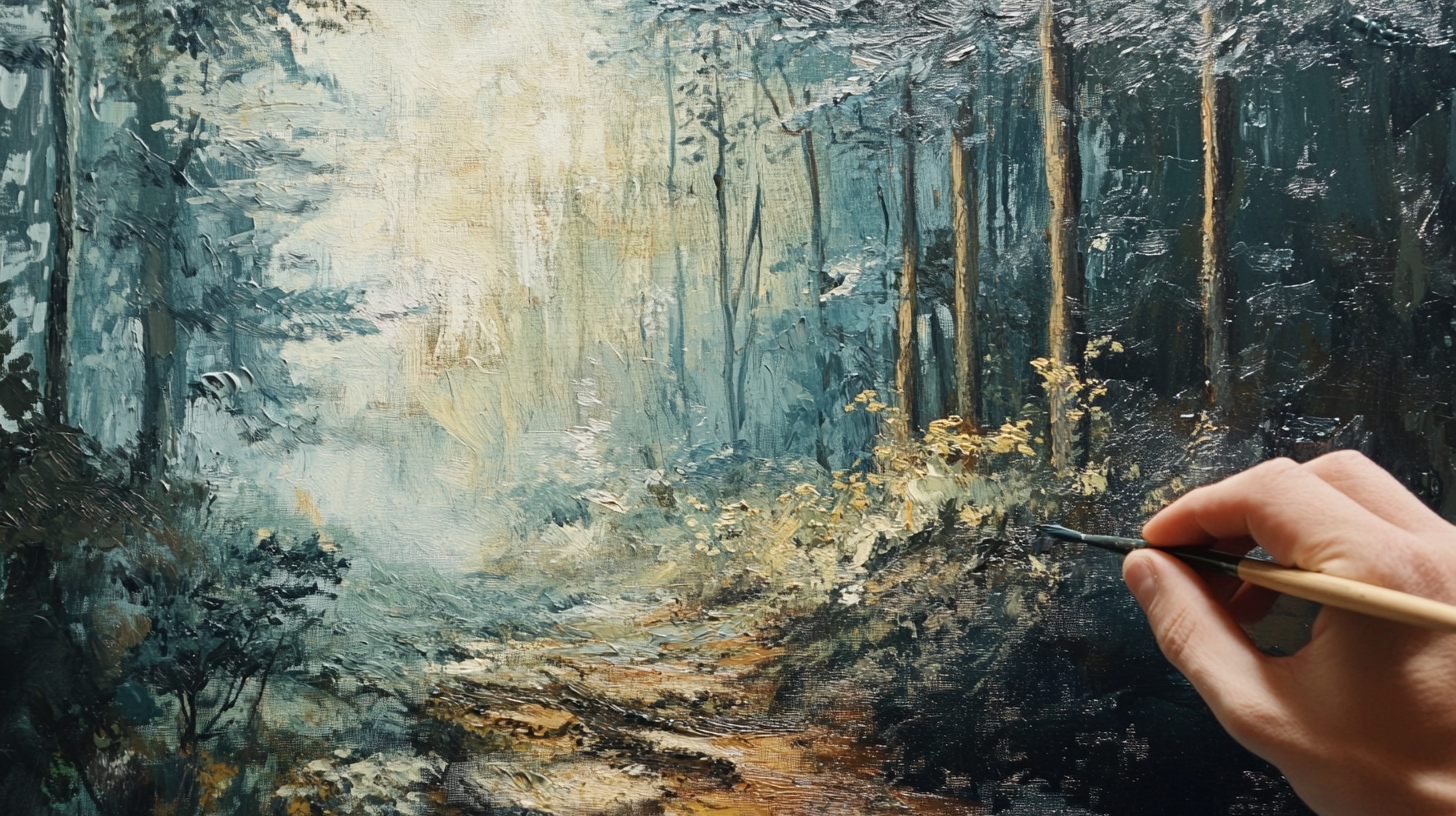
By combining layering and blending strategically, you can create convincing depth. Start with thinner, broader strokes for backgrounds and gradually move to thicker, detailed strokes in the foreground. Glazing over dry paint to adjust hues or deepen shadows, as well as using impasto for highlights, helps achieve a balanced and dynamic composition.
Advanced Layering Techniques
Consider these additional layering methods:
- Glazing: Thin, transparent layers to modify underlying colors
- Scumbling: Dry brush technique for texture and atmospheric effects
- Impasto: Thick paint application for dramatic texture and highlights
Mixing Oil Colors for Landscapes
Successful landscape painting requires a systematic approach to color mixing. Start by organizing your palette strategically - arrange primary colors and earth tones around the edges, leaving ample space in the center for mixing. Pre-mix several values (light, medium, dark) of your key colors before beginning to paint. This preparation allows you to work efficiently and maintain color consistency throughout your piece.
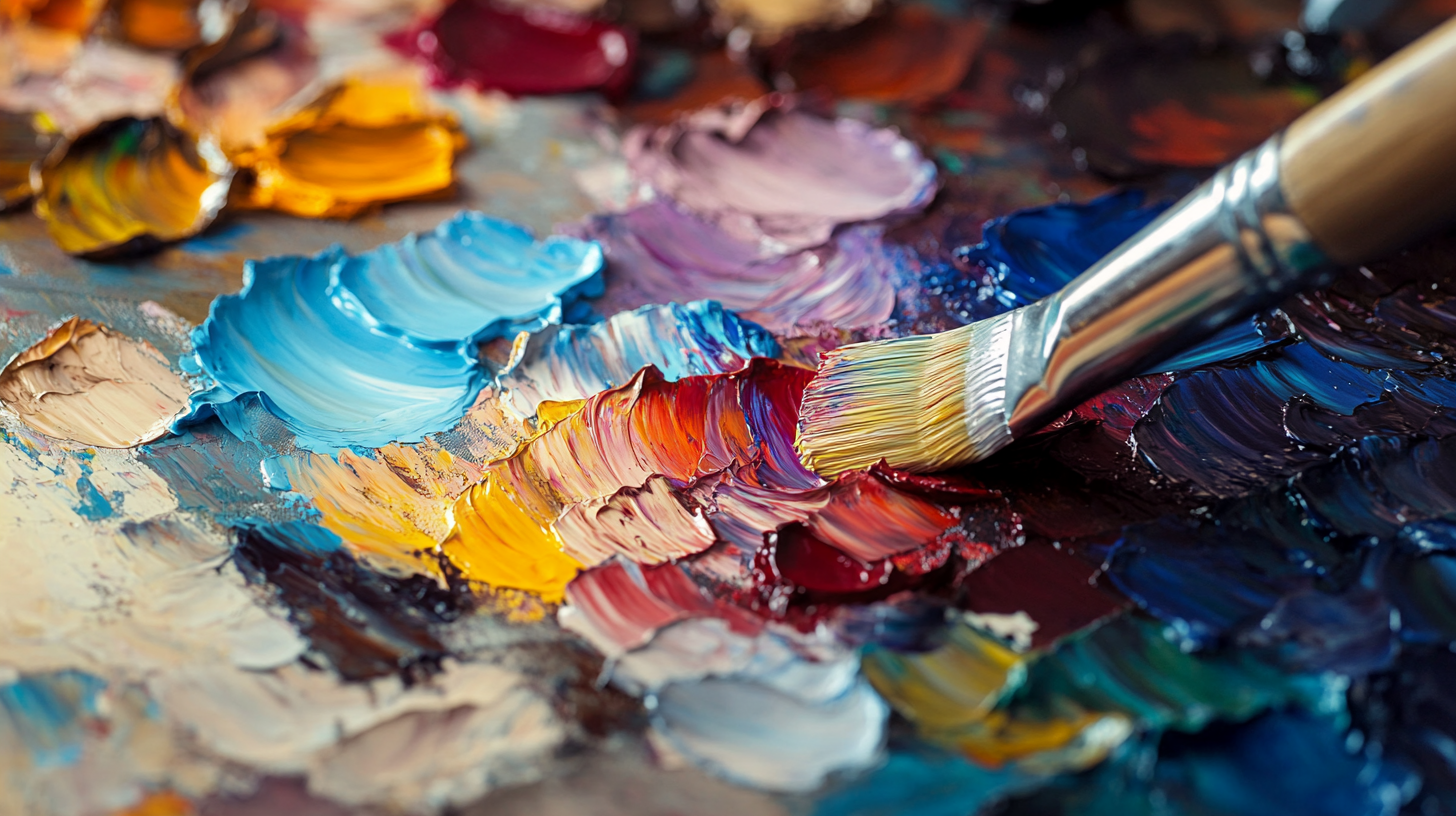
Essential Color Mixing Guide
Sky Colors
For clear skies, combine ultramarine blue with titanium white. Vary the ratio for different heights - more white near the horizon, less for zenith blue. Add minimal cadmium red or burnt sienna to suggest atmospheric perspective. For sunrise/sunset, incorporate alizarin crimson or cadmium orange to achieve warm violet or peach tones.
Foliage Greens
Create natural greens by mixing ultramarine blue with cadmium yellow. Adjust the mix:
- More yellow → sunlit, vibrant foliage
- More blue → cooler, shadowed areas
- Add alizarin crimson or burnt umber → muted olive tones
- Try different blue/yellow combinations for varied green hues
Water Effects
Water typically reflects the sky, but darker and slightly more muted. Mix ultramarine blue with a touch of viridian for deep water. Add Payne's gray or burnt umber for lake surfaces. For shallow water, incorporate sap green or burnt sienna to suggest underwater elements.
Earth and Mountain Tones
Create versatile earth tones by combining ultramarine blue with burnt sienna:
- More burnt sienna → warm soil and rocks
- More ultramarine → cool distant mountains
- Add white for atmospheric effects
- Mix in yellow ochre for sunlit areas
Advanced Mixing Techniques
Consider temperature and lighting when mixing colors. In warm light, add yellow to highlights and cool blues to shadows. For overcast scenes, use cooler highlights and warmer shadows. Test colors directly on the canvas or a test surface to ensure proper relationships between elements.
For precise color matching, digital tools like the Color to Oil Paint Converter can provide exact mixing ratios. While developing intuition through practice is essential, these resources can accelerate learning and ensure consistency across your work.
Enhancing Contrast and Highlights
One of the secrets to a striking, vibrant landscape oil painting is the effective use of contrast and highlights. Contrast refers to the difference between light and dark in your painting, and strong contrast can create a focal point and add drama. In a landscape, this might mean having deep, rich shadows against bright highlights where the sun hits, making the scene pop with three-dimensional depth. Think of a sunset landscape where the clouds have glowing edges (highlights) against a darker sky, or a forest scene with sunbeams illuminating parts of the canopy while the forest floor remains in shadow.
By intentionally boosting contrast in key areas, you draw the viewer's eye and make the image more dynamic. As you paint, continually evaluate your work from a few steps back: are the darkest areas dark enough and the lightest areas light enough? Avoid the common issue of everything settling into a middle-tone range. It's the extremes (used judiciously) that give a painting punch.
Adding highlights is usually one of the final steps in oil painting, and it's incredibly satisfying. Highlights bring sparkle and life – whether it's the glint of sunlight on water, the bright edge on clouds, or a sunlit haze over distant fields. The primary tool for highlights is often white (titanium white) or very light tints of color. But rather than using white straight from the tube (which can appear stark or chalky), mix your white with a bit of the local color or a warm tint.
For example, if you want to highlight sunlit grass, mixing a light yellow-green (white + a touch of cadmium yellow and a speck of blue) will look more natural than pure white. Reserve pure titanium white for the brightest specular highlights, like the intense gleam of the sun reflecting on water or the tip of the sun itself if it's in the frame.
Shadows are the counterbalance to highlights and are just as important in creating contrast. Avoid using straight black for shadows in landscape painting; it often looks dead and can muddy your colors. Instead, deepen shadows by mixing dark complements or using naturally dark pigments: a mix of ultramarine blue and burnt umber, or Alizarin crimson with phthalo green, can produce a rich near-black that has more vibrancy.
Essential Techniques for Contrast and Highlights
- Tinted Highlights: Apply your brightest areas last, using a light touch. Mix white with a bit of color (e.g., a dab of yellow or orange in white for warm sunlight) to create glowing highlights that match the scene's lighting. For instance, highlight the edges of clouds with a pale yellow-white to show golden hour sunlight. Using a palette knife to place thick, small highlights can add texture and brilliance.
- Deep, Luminous Shadows: Make sure your darks are deep enough to contrast with the lights. Create rich dark tones by mixing colors – a classic deep shadow mix is ultramarine blue + burnt umber (or + alizarin crimson) for a dark neutral that can lean cool or warm. Thin these darks with a medium for transparent shadow glazes that you can layer until you're happy with the depth.
- Focus with Contrast: Use your strongest contrast at your focal point to draw the eye. For example, if your landscape's focal point is a cottage, ensure the side facing the light is one of the lightest areas and something in its background or next to it is quite dark. Keep less important areas in a more moderate contrast so the viewer's eye isn't pulled everywhere equally.
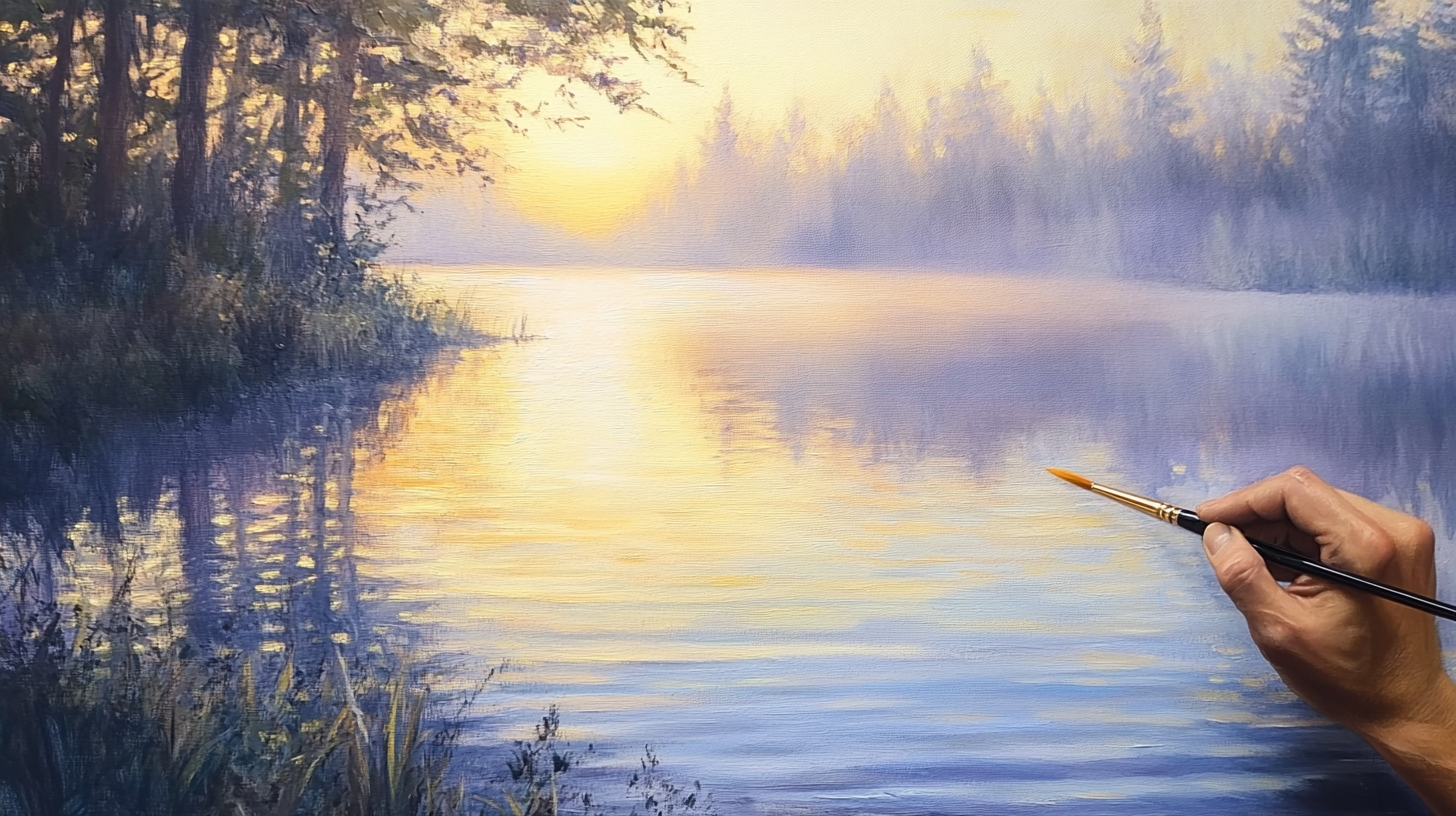
In summary, think of painting a landscape in terms of value design as much as color design. Ensure you have a full range from bright highlights to deep shadows. By carefully mixing for highlights (often lighter, warmer tones) and for shadows (darker, cooler tones) and placing them thoughtfully, you create a compelling play of light that gives your painting life. Contrast is what makes a painting leap off the canvas, so don't be shy about pushing those darks and lights once you have your midtones in place.
Common Mistakes and How to Fix Them
Even experienced artists encounter challenges when mixing colors for landscapes. Here are some common mistakes that can hinder the vibrancy of your oil painting, along with tips on how to correct or avoid them:
Overmixing Colors (Muddiness)
One frequent issue is overmixing on the palette (or scrubbing too much on the canvas) to the point where colors lose their intensity. When you mix too many different pigments together, especially complementary colors, you often end up with a dull brown or gray.
Fix: To avoid muddy colors, try using fewer colors in each mixture – rely on two or three pigments instead of five or six. Mix gradually and stop as soon as you reach the tone you need; don't keep stirring the paint unnecessarily. Also, clean your brush between mixing different color families. A dirty brush carrying remnants of complementary color can unintentionally neutralize your fresh mix. If a color on your canvas has turned muddy, let it dry, then paint a fresh layer of the correct color over it (or gently scrape it off if still wet). Glazing a pure, transparent color over a dull area can also revive its vibrancy. For example, if your greens became brownish, a thin glaze of a vivid transparent green (like viridian) can help bring back a lush tone.
Overly Dark or Washed-Out Areas
Sometimes a landscape can end up looking too dark and heavy overall, or conversely too pale and washed-out, lacking impact. This is usually due to imbalanced values or using too much of one extreme.
Fix: If your painting is too dark, identify the areas where the darkness isn't necessary and layer opaque lighter paint (mixed with white or a lighter color) on top to bring them up a notch. You might soften overly harsh shadows by gently blending in a bit of the local color mixed with white, or adding hints of reflected light (for instance, add a subtle blue-gray into very dark foreground shadows to suggest skylight). On the other hand, if everything looks washed-out (too light or low-contrast), you need to introduce stronger darks or boost saturation. You can deepen some shadow areas with a glaze of a dark transparent pigment like ultramarine blue or burnt umber – apply in thin layers until the value is rich enough. Additionally, check if your highlights are placed correctly: sometimes a painting looks flat if the highlights are too spread out or not bright enough where it matters. Consolidate your brightest values in the main lit areas and darken the areas that should be in shadow. This will increase overall contrast. Remember, a balanced composition usually has a mix of lights, midtones, and darks; if one category is missing, the picture may feel off.
Flat or Dull Composition (Lack of Dynamic Tones)
A landscape can also suffer from being technically correct in color mixing but still feel flat or boring because the tonal composition is monotonous. For instance, if most of your colors have the same mid-range value or everything has a similar color tone, the painting can lack energy.
Fix: Introduce tonal variety and color contrast in your composition. This might mean pushing some areas to be warmer or cooler in color temperature for contrast (e.g., make the foreground a bit warmer and the background cooler to separate them). It could also involve adding a pop of complementary color in a small but crucial area – like a dash of red wildflowers in a sea of green field – to break the monotony. Check your focal point: is it defined by sharper contrast or more intense color compared to the rest of the painting? If not, enhance it by either brightening the highlight or deepening the shadow at that spot. Also consider edges and textures – a very uniform blending everywhere can make a painting feel lifeless. Try introducing some crisp edges or textured brushstrokes in the foreground to contrast with softer blends in the distance. In essence, ensure your painting has highs and lows: a range of values and a balance of soft and sharp, calm and detailed. If you find an area is not contributing to the overall dynamic, don't be afraid to rework it by adjusting the color mix or layering another glaze/coat until it sings within the composition.
By being mindful of these pitfalls as you work, you can catch problems early. Step back from your painting periodically or even look at it in a mirror to get a fresh perspective on the overall color and value balance. If something looks off, it likely is – identify if it's a color issue (hue too intense or dull) or a value issue (too dark/light) and use the above strategies to correct it. The beauty of oil paint is its forgiveness; once a layer is dry you can always glaze, scumble, or completely paint over areas to adjust the color and tone. Each mistake is an opportunity to learn, and knowing how to fix issues will make you a much more confident painter.
Final Thoughts and Additional Resources
Color mixing and layering in oil painting is an art that grows with experience and experimentation. As an intermediate or advanced artist, refining your techniques can transform your work. Experiment with new combinations, test different layering orders, and don't be afraid to break the rules creatively.
For precise color mixing guidance, consider using digital tools like the Color to Oil Paint Converter available online. This tool can provide detailed recipes for mixing specific hues, helping you achieve consistency across your work.
Ultimately, mastering these advanced techniques will give your landscapes depth, vibrancy, and life. Practice and patience are your best allies on this creative journey. Happy painting!
Practice Exercises
To improve your color mixing skills:
- Create color charts mixing primaries in different ratios
- Practice matching colors from nature or photographs
- Experiment with limited palettes to understand color relationships
